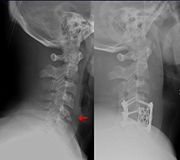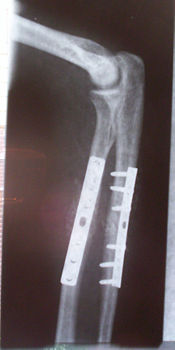Orthopedic surgery


Orthopedic surgery or orthopedics (also spelled orthopaedics) is the branch of surgery concerned with injuries to, or conditions involving, the musculoskeletal system. Orthopedic surgeons address most muscle injuries that require surgery, and some are also skilled at dealing with congenital conditions that result in orthopedic deformities, such as spastic cerebral palsy, using both surgical and non-surgical means.
Nicholas Andry coined the word "orthopaedics", derived from Greek words for orthos ("correct", "straight") and paideia ("rearing" (usually of child)), in 1741, when at the age of 81 he published Orthopaedia: or the Art of Correcting and Preventing Deformities in Children.
In the US the spelling orthopedics is standard, although the majority of university and residency programs, and even the AAOS, still use Andry's spelling. Elsewhere, usage is not uniform; in Canada, both spellings are common; orthopaedics usually prevails in the rest of the Commonwealth, especially in Britain.
Contents |
Training
In the United States and Canada orthopedic surgeons are physicians who have completed applied training in orthopedic surgery after the completion of medical school and attainment of the conventional (MD, MBBS, MBChB, etc) or osteopathic (DO) degree. According to the latest Occupational Outlook Handbook (2006–2007) published by the US Department of Labor, between 3–4% of all practicing physicians are orthopedic surgeons.
Orthopedic surgeons complete a minimum of 10 years of postsecondary education & clinical training. This training can include obtaining an undergraduate degree for entry into medical school, an MD MBBS, MBChB, etc or in america an osteopathic (DO) degree, and then completing a five-year residency in orthopedic surgery. The five-year residency consists of one year of general surgery training followed by four years of training in orthopedic surgery.
After completion of specialty residency/registrar training, an orthopedic surgeon is then eligible for board certification in the United States. In Canada it leads to eligibility for Certification by and Fellowship of the Royal College of Physicians and Surgeons of Canada. In Australia and New Zealand it leads to eligibility for Fellowship of the Royal Australasian College of Surgeons. Certification by the American Board of Orthopaedic Surgery means that the orthopaedic surgeon has met the specified educational, evaluation, and examination requirements of the Board[1]. The process requires successful completion of a standardized written exam followed by an oral exam focused on the surgeon's clinical and surgical performance over a 6 month period.
Many orthopedic surgeons elect to do further subspecialty training in programs known as 'fellowships' after completing their residency training. Fellowship training in an orthopedic subspeciality is typically one year in duration (sometimes two) and usually has a research component involved with the clinical and operative training. Examples of orthopedic subspecialty training in the US are:
- Hand surgery (also performed by Plastic and General Surgeons)
- Shoulder and elbow surgery
- Total joint reconstruction (arthroplasty)
- Pediatric orthopedics
- Foot and ankle surgery (Also performed by podiatric surgeons)
- Spine surgery
- Musculoskeletal oncology
- Surgical sports medicine
- Orthopedic trauma
Specialists in hand surgery and sports medicine may obtain a Certificate of Added Qualifications (CAQ) in addition to their board certification by successfully completing an separate standardized examination. There is no additional certification process for the other subspecialties.
Practice
According to applications for board certification from 1999 to 2003, the top 25 most common procedures (in order) performed by orthopedic surgeons are as follows[2]:
- Knee arthroscopy and meniscectomy
- Shoulder arthroscopy and decompression
- Carpal tunnel release
- Knee arthroscopy and chondroplasty
- Removal of support implant
- Knee arthroscopy and anterior cruciate ligament reconstruction
- Knee replacement
- Repair of femoral neck fracture
- Repair of trochanteric fracture
- Debridement of skin/muscle/bone/fracture
- Knee arthroscopy repair of both menisci
- Hip replacement
- Shoulder arthroscopy/distal clavicle excision
- Repair of rotator cuff tendon
- Repair fracture of radius (bone)/ulna
- Laminectomy
- Repair of ankle fracture (bimalleolar type)
- Shoulder arthroscopy and débridement
- Lumbar spinal fusion
- Repair fracture of the distal part of radius
- Low back intervertebral disc surgery
- Incise finger tendon sheath
- Repair of ankle fracture (fibula)
- Repair of femoral shaft fracture
- Repair of trochanteric fracture
A typical schedule for a practicing orthopedic surgeon involves 50-55 hours of work per week divided among clinic, surgery, various administrative duties and possibly teaching and/or research if in an academic setting. In 2007, the median salary for an orthopedic surgeon in the United States is $388,784.[3]
History

Jean-Andre Venel established the first orthopedic institute in 1780, which was the first hospital dedicated to the treatment of children's skeletal deformities. He is considered by some to be the father of orthopedics or the first true orthopedist in consideration of the establishment of his hospital and for his published methods.
Antonius Mathysen, a Dutch military surgeon, invented the plaster of Paris cast in 1851.
Many developments in orthopedic surgery resulted from experiences during wartime. On the battlefields of the Middle Ages the injured were treated with bandages soaked in horses' blood which dried to form a stiff, but unsanitary, splint. Traction and splinting developed during World War I. The use of intramedullary rods to treat fractures of the femur and tibia was pioneered by Dr. Kuntschner of Germany. This made a noticeable difference to the speed of recovery of injured German soldiers during World War II and led to more widespread adoption of intramedullary fixation of fractures in the rest of the world. However, traction was the standard method of treating thigh bone fractures until the late 1970s when the Harborview Medical Center in Seattle group popularized intramedullary fixation without opening up the fracture. External fixation of fractures was refined by American surgeons during the Vietnam War but a major contribution was made by Gavril Abramovich Ilizarov in the USSR. He was sent, without much orthopedic training, to look after injured Russian soldiers in Siberia in the 1950s. With no equipment he was confronted with crippling conditions of unhealed, infected, and malaligned fractures. With the help of the local bicycle shop he devised ring external fixators tensioned like the spokes of a bicycle. With this equipment he achieved healing, realignment and lengthening to a degree unheard of elsewhere. His Ilizarov apparatus is still used today as one of the distraction osteogenesis methods.
David L. MacIntosh pioneered the first successful surgery for the management of the torn anterior cruciate ligament of the knee. This common and serious injury in skiers, field athletes, and dancers invariably brought an end to their athletics due to permanent joint instability. Working with injured football players, Dr. MacIntosh devised a way to re-route viable ligament from adjacent structures to preserve the strong and complex mechanics of the knee joint and restore stability. The subsequent development of ACL reconstruction surgery has allowed numerous athletes to return to the demands of sports at all levels.
Modern orthopaedic surgery and musculoskeletal research has sought to make surgery less invasive and to make implanted components better and more durable.
Arthroscopy
The use of arthroscopic tools has been particularly important for injured patients. Arthroscopy was pioneered in the early 1950's by Dr. Masaki Watanabe of Japan to perform minimally invasive cartilage surgery and re-constructions of torn ligaments. Arthroscopy helped patients recover from the surgery in a matter of days, rather than the weeks to months required by conventional, 'open' surgery. Knee arthroscopy is one of the most common operations performed by orthopedic surgeons today and is often combined with meniscectomy or chondroplasty.
Joint replacement
The modern total hip replacement was pioneered by Sir John Charnley in England in the 1960s.[4] He found that joint surfaces could be replaced by metal or high density polyethylene implants cemented to the bone with methyl methacrylate bone cement. Since Charnley, there have been continuous improvements in the design and technique of joint replacement (arthroplasty) with many contributors, including W. H. Harris, the son of R. I. Harris, whose team at Harvard pioneered uncemented arthroplasty techniques with the bone bonding directly to the implant.
Knee replacements using similar technology were started by McIntosh in rheumatoid arthritis patients and later by Gunston and Marmor for osteoarthritis in the 1970s.developed by Dr. John Insall and Dr. Chitranjan Singh Ranawat in New York utilizing a fixed bearing,[5] and by Dr Frederick Buechel and Dr Michael Pappas utilizing a mobile bearing.[6] Uni-compartment knee replacement, in which only one side of an arthritic knee is replaced, is a smaller operation and has become popular recently.
Joint replacements are available for other joints on a limited basis, most notably shoulder, elbow, wrist, ankle, and fingers.
In recent years, surface replacement of joints, in particular the hip joint, have become more popular amongst younger and more active patients. This type of operation delays the need for the more traditional and less bone-conserving total hip replacement, but carries significant risks of early failure from fracture and bone death.
One of the main problems with joint replacements is wear of the bearing surfaces of components. This can lead to damage to surrounding bone and contribute to eventual failure of the implant. Use of alternative bearing surfaces has increased in recent years, particularly in younger patients, in an attempt to improve the wear characteristics of joint replacement components. These include ceramics and all-metal implants (as opposed to the original metal-on-plastic). The plastic (actually ultra high molecular weight polyethylene) can also be altered in ways that may improve wear characteristics.
WHOA!!!
References
- ↑ American Board of Orthopaedic Surgery
- ↑ *Garrett, WE, et al. American Board of Orthopaedic Surgery Practice of the Orthopedic Surgeon: Part-II, Certification Examination. The Journal of Bone and Joint Surgery (American). 2006;88:660-667.
- ↑ Average Orthopedic Surgeon Salary. Orthopedic Surgeon Job, Career Education & Unemployment Help from Salary.com
- ↑ Wroblewski, B.M. (2002). "Professor Sir John Charnley (1911–1982)". Rheumatology (The British Society for Rheumatology via Oxford Journals) 41 (7): 824–825. doi:. PMID 12096235. http://rheumatology.oxfordjournals.org/cgi/content/full/41/7/824. Retrieved on 2008-04-28.
- ↑ Ranawat, C.S. (2002). "History of total knee replacement". J South Orthop Assoc 11 (4): 218–226. http://www.ncbi.nlm.nih.gov/pubmed/12597066. Retrieved on 2008-04-28.
- ↑ Hamelynck, K.J. (2006). "The history of mobile-bearing total knee replacement systems". Orthopedics 29 (9 Suppl): S7–12. http://www.ncbi.nlm.nih.gov/pubmed/17002140. Retrieved on 2008-04-28.
See also
- Bone grafting
- Brostrom prodedure
- Computer-Assisted Orthopedic Surgery
- Arbeitsgemeinschaft für Osteosynthesefragen
- Gait analysis
- Halo Brace.
- Hand surgery
- Orthopaedic nursing
- Traction
- Partial knee replacement
External links
- Washington University Orthopedics
- Oxford Clinic for Specialist Surgery - Orthopaedic Hospital
- Yale Orthopaedics
- The History of Orthopaedics
- Wheeless' Textbook of Orthopaedics
- The International Society of Orthopaedic Surgery and Traumatology
- American Academy of Orthopaedic Surgeons
- American Orthopaedic Society for Sports Medicine
- Pediatric Orthopaedics
- AO Surgery Reference
- The Journal of Bone and Joint Surgery
- Orthopedics News
- Orthopedic Surgery Articles written by Paul Baxt, MD
- The Institute for Arthroscopy and Sports Medicine - Jeffrey Halbrecht, MD
|
|||||||||||||||||||||||||||||||